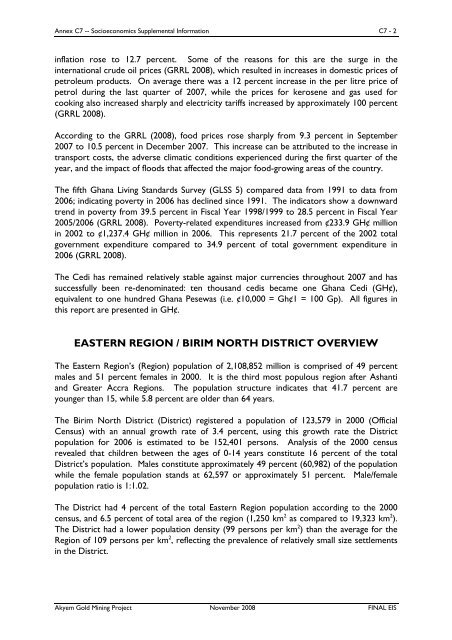annexc - Newmont Mining Corporation
annexc - Newmont Mining Corporation
annexc - Newmont Mining Corporation
Create successful ePaper yourself
Turn your PDF publications into a flip-book with our unique Google optimized e-Paper software.
Annex C7 -- Socioeconomics Supplemental Information C7 - 2<br />
inflation rose to 12.7 percent. Some of the reasons for this are the surge in the<br />
international crude oil prices (GRRL 2008), which resulted in increases in domestic prices of<br />
petroleum products. On average there was a 12 percent increase in the per litre price of<br />
petrol during the last quarter of 2007, while the prices for kerosene and gas used for<br />
cooking also increased sharply and electricity tariffs increased by approximately 100 percent<br />
(GRRL 2008).<br />
According to the GRRL (2008), food prices rose sharply from 9.3 percent in September<br />
2007 to 10.5 percent in December 2007. This increase can be attributed to the increase in<br />
transport costs, the adverse climatic conditions experienced during the first quarter of the<br />
year, and the impact of floods that affected the major food-growing areas of the country.<br />
The fifth Ghana Living Standards Survey (GLSS 5) compared data from 1991 to data from<br />
2006; indicating poverty in 2006 has declined since 1991. The indicators show a downward<br />
trend in poverty from 39.5 percent in Fiscal Year 1998/1999 to 28.5 percent in Fiscal Year<br />
2005/2006 (GRRL 2008). Poverty-related expenditures increased from ¢233.9 GH¢ million<br />
in 2002 to ¢1,237.4 GH¢ million in 2006. This represents 21.7 percent of the 2002 total<br />
government expenditure compared to 34.9 percent of total government expenditure in<br />
2006 (GRRL 2008).<br />
The Cedi has remained relatively stable against major currencies throughout 2007 and has<br />
successfully been re-denominated: ten thousand cedis became one Ghana Cedi (GH¢),<br />
equivalent to one hundred Ghana Pesewas (i.e. ¢10,000 = Gh¢1 = 100 Gp). All figures in<br />
this report are presented in GH¢.<br />
EASTERN REGION / BIRIM NORTH DISTRICT OVERVIEW<br />
The Eastern Region’s (Region) population of 2,108,852 million is comprised of 49 percent<br />
males and 51 percent females in 2000. It is the third most populous region after Ashanti<br />
and Greater Accra Regions. The population structure indicates that 41.7 percent are<br />
younger than 15, while 5.8 percent are older than 64 years.<br />
The Birim North District (District) registered a population of 123,579 in 2000 (Official<br />
Census) with an annual growth rate of 3.4 percent, using this growth rate the District<br />
population for 2006 is estimated to be 152,401 persons. Analysis of the 2000 census<br />
revealed that children between the ages of 0-14 years constitute 16 percent of the total<br />
District’s population. Males constitute approximately 49 percent (60,982) of the population<br />
while the female population stands at 62,597 or approximately 51 percent. Male/female<br />
population ratio is 1:1.02.<br />
The District had 4 percent of the total Eastern Region population according to the 2000<br />
census, and 6.5 percent of total area of the region (1,250 km 2 as compared to 19,323 km 2 ).<br />
The District had a lower population density (99 persons per km 2 ) than the average for the<br />
Region of 109 persons per km 2 , reflecting the prevalence of relatively small size settlements<br />
in the District.<br />
Akyem Gold <strong>Mining</strong> Project November 2008 FINAL EIS











